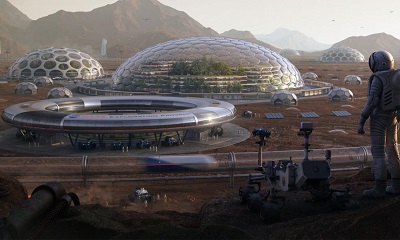 Friday, July 26, 2024
Friday, July 26, 2024  Friday, July 26, 2024
Friday, July 26, 2024 

An urban utopia on Mars might be closer than you think.
For the past year, creative professionals, students, space geeks — even families — have been creating their visions for a metropolis on the fourth planet from the sun. The final winners of the HP Mars Home Planet challenge were announced today by HP and unveiled in a VR experience at SIGGRAPH 2018, an annual computer graphics convention, in Vancouver.
“The amazing entries from the HP Mars Home Planet challenge give us a virtual window into what life on Mars could be like for a million members of humanity,” says judge Dr. Darlene Lim, a geobiologist and principal investigator, NASA Biologic Analog Science. “Technological advancement is being met by a broad array of foundational space science and planetary research — a confluence that will optimistically serve to accelerate our path toward human exploration and settlement of Mars.”
Freezing cold and with an atmosphere 100 times thinner than Earth’s, Mars is a hostile environment for life as we know it. How do you protect people and plants from lethal radiation rays or vicious sand storms? What kind of transport can move people and supplies around in Mars’ weak gravity? How will energy be created — not to mention enough oxygen to sustain humans? What will be done with waste? Imaginative and clever enthusiasts from Earth rolled up their sleeves and committed months of personal time to their ideas on how humans could flourish on the Red Planet.
The year-long competition exceeded expectations and inspired more than 87,000 creative pros, students, scientists and space fans from more than150 countries to imagine how life would work for an established colony of one million people. The public challenge was made up of three competitions: Concept, 3D Modeling and Rendering. (Read about the previous two rounds here and here.)
All the submissions had to consider the physical constraints of the alien environment. In the concept phase of the contest, close to 500 entries were evaluated for potential to sustain a meaningful life for a million humans. For the 3D modeling phase, a new set of teams and individuals submitted more than 330 designs and 3D models. All participants used 40 square km of actual Mars terrain developed by Fusion for its Mars 2030 game, based on NASA research and high-resolution photographs.
In the final phase, a fresh group of visionaries and explorers-at-heart created renderings of what life in Mawrth Vallis (Mars Valley) — a NASA-identified landing site — could look and feel like for one million inhabitants. Nearly 180 still, animated, real-time or VR renderings addressed two main categories: architecture/civil engineering and vehicles/mechanical engineering.
Watch our video and learn more about the benefits of joining Construction Links Network – the peer-to-peer network sharing platform for the construction, building and design community.
Press Releases | Project Updates | New Appointments | Awards & Milestones | Company News | New Products/Services | Brochures | Videos | Infographics | Blog Sharing | Events and More